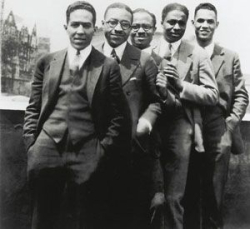Sanford Pinsker in VQR:
 Enter the new generation of black intellectuals—everyone from Henry Louis Gates, Jr., Stephen Carter, and Cornel West to Shelby Steele, Orlando Patterson and Stanley Crouch. Taken together, they represent a direction that began 40 years ago with the Brown vs. Board of Education decision and continued through the civil rights movement. In short, the black intellectual voices now speaking out from our most prestigious universities are, as the title of Stephen Carter’s 1991 book would have it, “affirmative action babies.” From token representation in the 1950’s and 60’s-—when, say, Harvard typically admitted ten blacks per class—enrollments have fairly soared as Afro-American studies programs took root (often in response to student protest) and universities slowly but surely embraced a new educational paradigm based on race, class, and gender. In the process, culture became, well, one of those words. It was once spelt with a capital letter, defined by Matthew Arnold as “the best that has been thought and said,” and generally agreed to be a good thing. Now, many in the academy were not so sure, partly because selecting the “best” invariably means leaving out the “least,” and partly because culture itself often seems to be a suspect operation. Rather than “sweetness and light” (the title of the Arnold essay in which his famous definition appeared), “culture”— yet another term destined to be surrounded by inverted commas—stands for everything that first bullies and then silences minority voices.
Enter the new generation of black intellectuals—everyone from Henry Louis Gates, Jr., Stephen Carter, and Cornel West to Shelby Steele, Orlando Patterson and Stanley Crouch. Taken together, they represent a direction that began 40 years ago with the Brown vs. Board of Education decision and continued through the civil rights movement. In short, the black intellectual voices now speaking out from our most prestigious universities are, as the title of Stephen Carter’s 1991 book would have it, “affirmative action babies.” From token representation in the 1950’s and 60’s-—when, say, Harvard typically admitted ten blacks per class—enrollments have fairly soared as Afro-American studies programs took root (often in response to student protest) and universities slowly but surely embraced a new educational paradigm based on race, class, and gender. In the process, culture became, well, one of those words. It was once spelt with a capital letter, defined by Matthew Arnold as “the best that has been thought and said,” and generally agreed to be a good thing. Now, many in the academy were not so sure, partly because selecting the “best” invariably means leaving out the “least,” and partly because culture itself often seems to be a suspect operation. Rather than “sweetness and light” (the title of the Arnold essay in which his famous definition appeared), “culture”— yet another term destined to be surrounded by inverted commas—stands for everything that first bullies and then silences minority voices.
No one would seriously argue with the proposition that black intellectuals have played a major role in the culture wars that define our time. Indeed, some would insist that they are what the New York intellectuals once were— namely, activist scholars who bring fresh blood and new perspectives to our understanding of American culture. At the same time, however, there are important differences. Regardless of how much the New York intellectuals were divided by temperament and later, by politics, they shared a fund of common experience that, for want of a better term, might be called “immigrant gratitude.” America, and perhaps more to the point, American culture, offered an escape from the hardships and parochial limitations that had narrowly defined the lives of their immigrant parents. Granted, the giddy possibility of self-transformation did not come without cost, and it would take a long arc indeed before many would rediscover the Jewishness from which they had fled. Not surprisingly, the conflict was the very stuff of which intellectuals, rather than scholars, are made, for as Daniel Bell once shrewdly observed, the scholar finds his place within an established tradition and adds his tiny piece to the mosaic. By contrast, the intellectual begins with “HIS experience, HIS individual perceptions of the world, HIS privileges and deprivations, and judges the world by these sensibilities.”
More here. (Note: At least one post throughout February will be in honor of Black History Month)
The ideals of liberalism seem increasingly under threat these days, so it’s worth reviewing what they are, where they come from, and why it’s essential that they make a comeback (a PDF version of this essay is available here). The first step is to recognize that they were not invented by some obsolete English philosopher. Rather, in their most general form, liberal principles have been rediscovered repeatedly and throughout history as practical tools for reconciling two basic social facts:
